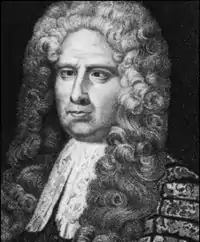2nd Parliament of King William III and Queen Mary II
The 2nd Parliament of King William III and Queen Mary II was summoned by William III of England and Mary II of England on 6 February 1690 and assembled on 20 March 1690.

The new Parliament was more or less equally divided along party lines, with 243 Whig and 241 Tory members, plus 28 others. Sir John Trevor was installed as Speaker of the House of Commons. The ministry, however, was not formed on party lines but drawn from both parties, albeit dominated by Tories. Its nominal head was the Lord Treasurer, Marquess of Carmarthen.
In the second session a number of innovative measures were approved to deal with the question of raising the large amounts of short-term money required to finance the wars in Ireland and the Low Countries. These introduced the practice of deficit financing and an institutionalized National Debt.
By 1694, towards the end of the Parliament, the Whig party, lead by the First Whig Junto, were in the ascendancy and dominating the government. The 1693–94 session concerned itself with the raising of huge amounts of money to support the war effort. A financial crisis was averted when the new Chancellor of the Exchequer, Charles Montagu introduced the successful Million Lottery and established the Bank of England.
The 6th and last session of the Parliament began in November 1694. After the death of Queen Mary in December the Tories were again resurgent and highly critical of the cost and conduct of the war with France. But accusations of corruption against certain leading Tories resulted in the replacement of the Speaker by Paul Foley and the impeachment of Lord Carmarthen, now the Duke of Leeds. The scandals obliged the King to dissolve the Parliament on 11 October 1695.[1]
Notable Acts of the Parliament
See also
- 1690 English general election
- Carmarthen ministry 1690–1694
- Acts of the Parliament of England/William III & Mary II
- List of Parliaments of England
References
- "No. 3122". The London Gazette. 10 October 1695. p. 1.
- "The 2nd Parliament of William and Mary". History of Parliament Online. Retrieved 4 November 2017.
.svg.png.webp)